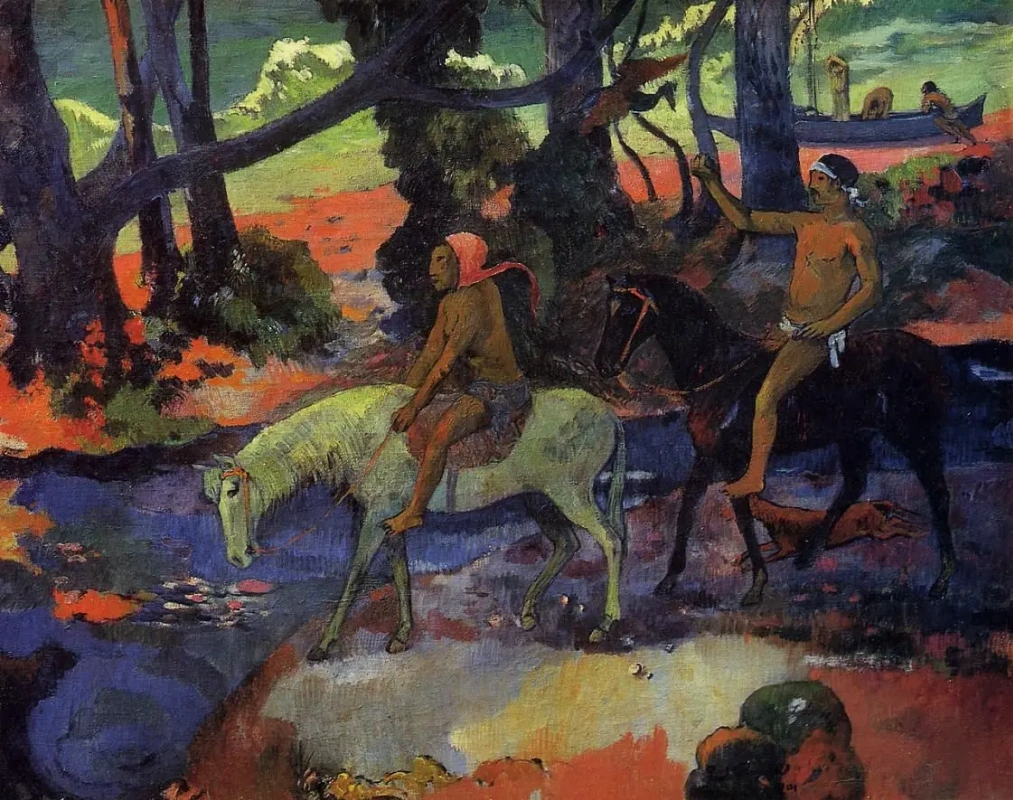log in
Enter site
Login to use Arthive functionality to the maximum
The Ford. The Flight
Paul Gauguin • Painting, 1901, 76×95 cm


















Description of the artwork «The Ford. The Flight»
Throughout his life, Paul Gauguin tried to flee from disappointments in work, family, friends, women and his native country... Ironically, each of his flights brought only new disappointments. Having left France for Tahiti, he never found the world he had dreamed of: the one, where people live in complete harmony with the pristine nature, untouched by civilization. Returning home only aggravated the situation: Gauguin's Tahitian paintings, which the artist considered the best of his creations, were cruelly ridiculed. Leaving his native shores for good, the artist went back to the Islands, but still could not find peace.
In 1898, afflicted by the news of his beloved daughter's death, suffering from poverty and disease, having nothing to eat, Gauguin dared to make his last escape. After completing the monumental painting "Where do we come from? What are we? Where are we going?" he went up into the mountains and took a large dose of arsenic. But his body rejected the poison, and the artist survived. After a while, Gauguin's financial situation slightly improved, which allowed him to improve his health. But his anxiety and feeling of restlessness didn't seem to disappear. In 1901, living in the Marquesas Islands, the artist created a painting "The Ford. The Flight", filled with gloomy symbolism.
At first glance, it is the most ordinary scene from the tropical life. However, art historians find in this painting several images that refer to ancient myths and biblical stories related to death. For example, the central figure on the canvas (most likely a woman) hints at the line "... And I looked, and behold a pale horse: and his name that sat on him was Death..." A man riding behind on a dark horse gives a piece of raw meat to a vulture - a bird of prey, which also symbolizes death. This suggests that the second subject of the painting is a kind of native Charon, a guide to the Kingdom of the Dead, and the river in front of which the riders stopped is the very River of Oblivion that separates the characters from the World of the Living.
Paul Gauguin died two years after the creation of this painting. On the nightstand beside his bed an empty bottle of laudanum was found.
In 1898, afflicted by the news of his beloved daughter's death, suffering from poverty and disease, having nothing to eat, Gauguin dared to make his last escape. After completing the monumental painting "Where do we come from? What are we? Where are we going?" he went up into the mountains and took a large dose of arsenic. But his body rejected the poison, and the artist survived. After a while, Gauguin's financial situation slightly improved, which allowed him to improve his health. But his anxiety and feeling of restlessness didn't seem to disappear. In 1901, living in the Marquesas Islands, the artist created a painting "The Ford. The Flight", filled with gloomy symbolism.
At first glance, it is the most ordinary scene from the tropical life. However, art historians find in this painting several images that refer to ancient myths and biblical stories related to death. For example, the central figure on the canvas (most likely a woman) hints at the line "... And I looked, and behold a pale horse: and his name that sat on him was Death..." A man riding behind on a dark horse gives a piece of raw meat to a vulture - a bird of prey, which also symbolizes death. This suggests that the second subject of the painting is a kind of native Charon, a guide to the Kingdom of the Dead, and the river in front of which the riders stopped is the very River of Oblivion that separates the characters from the World of the Living.
Paul Gauguin died two years after the creation of this painting. On the nightstand beside his bed an empty bottle of laudanum was found.
Recommended artworks:













